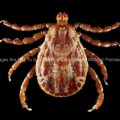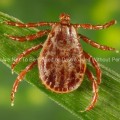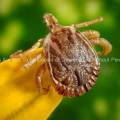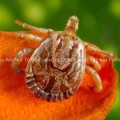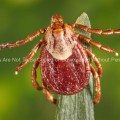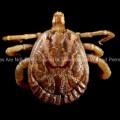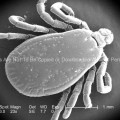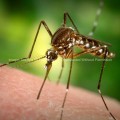This 2005 image depicted a male “brown dog tick”, Rhipicephalus sanguineus from a superior, or dorsal view looking down on this “hard tick’s” scutum, or keratinized “shield” which entirely covers its back, identifying it as a male. In the female, the dorsal abdomen is only partially covered, thereby, offering room for abdominal expansion when she becomes engorged with blood while ingesting her blood meal obtained from her host.
Though not the primary vector for Rocky Mountain spotted fever (RMSF) like the “American dog tick”, Dermacentor variabilis, and the “Rocky Mountain wood tick” D. andersoni, R. sanguineus has been found to be a less-common vector as well. This tick is distributed throughout the world. It also is known to transmit diseases to animals including canine babesiosis, bovine anaplasmosis, East Coast fever and Texas cattle fever. It can also spread tularemia, and tick-borne typhus to human beings.
RMSF, like all rickettsial infections, is classified as a zoonosis. Zoonoses are diseases of animals that can be transmitted to humans. Many zoonotic diseases require a biological vector (e.g., a mosquito, tick, flea, or mite) in order to be transmitted from the animal host to the human host. In the case of Rocky Mountain spotted fever, ticks are the natural hosts, serving as both reservoirs and vectors of Rickettsia rickettsii. Ticks transmit the organism to vertebrates primarily by their bite. Less commonly, infections may occur following exposure to crushed tick tissues, fluids, or tick feces.
R. rickettsii usually infects members of the tick family Ixodidae spp. (hard ticks), however, a closely related rickettsial specie has been found in the soft “bat tick”, Carios kelleyi. These ticks have four stages in their life cycle: egg, larva, nymph, and adult. Both male and female ticks will bite.

